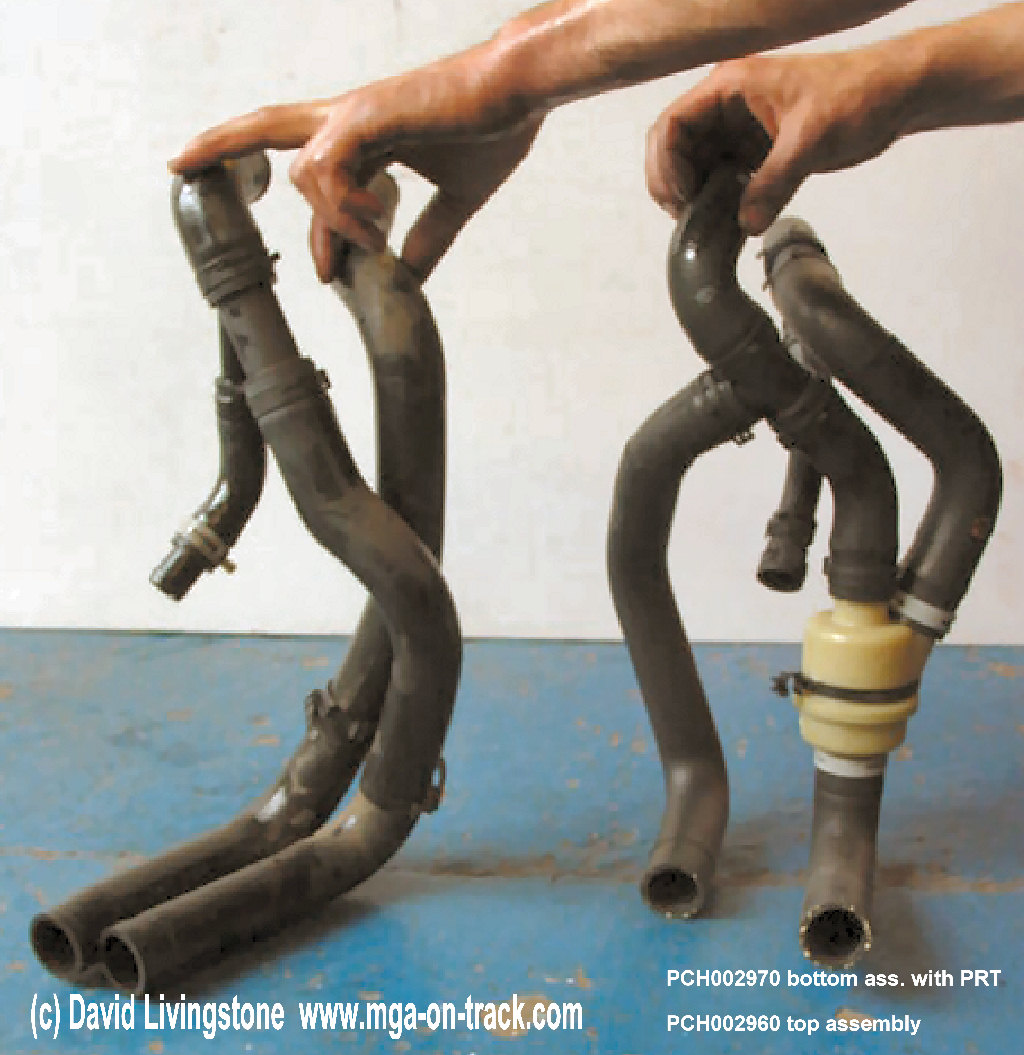Mirror of the Document
written by © Simon (S) Original 05.07.2001 copied with permission
from Simons Website
I enhanced the document 31.12.01
with the affiliated coolant flow diagrams from the MGF [Dieter Koennecke]
Got the Remote Thermostat from Carl.
Under Construction !!!
PRRT @ Carlos & look how John F. worked the PRT worked it out
Head gaskets failure on the K happens for a number of reasons:
- Bad liner height tolerance.
- Incorrect bolt down torque.
- Excessive revs.
- Poor temperature control.
- Fuelling too lean (pre-ignition)
- suddenly water loss
- Broken cam belt tensioner
NOTICE: At the MGF is a
reasonable difference in the cooling system. The heater [No 11] is at
the MGF controlled with a valve [No 7]. At the Elise is a constant coolant
flow, cause the heater has no valve. Heat for the passenger room is controlled
with air flaps !!
Normally itís a combination of these.
The cooling problem has two sides, water temp and oil temp. What you have to remember here is that the K was designed as a 1.4 for use in low to mid powered FWD cars, the Elise/MGF fly in the face of this in that they are both 1.8 versions with the engine in the rear (OK mid to be pedantic!).
When installed in the typical FWD car (say Rover 200), the radiator is only some 6 inches away from the engine, the sump is sticking out into the airflow under the car, and itís only producing some 90-120Bhp.
From the cooling systems design, the priority was to get the engine up to temp as fast as possible (for emissions/economy etc) thus a closed loop system was created with the stat controlled by the by-pass water. This means that until the stat opens, only the volume of water in the engine jacket and bypass pipe (also the internal heater on most cars), about 3 litres, is circulating, not much water to heat up.
When the stat opens, it does
not have to open very far to get enough cold water to balance the system,
and even when the car is stationary, the whole system just starts to flow
more water.
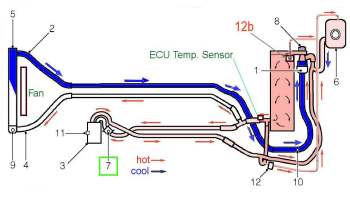
The problem comes when the radiator cct holds vastly more water than the engine (something like 12 litres on the Elise/MGF). All works fine for the std car that just trolls around, spending very little time on full throttle at speeds over 70Mph.
The problems start when the engine is up-rated, driven at 100+ mph, full throttle for 20+ seconds. What happens is that the water back from the radiator gets very cold because of the huge amounts of air forced though it at speed and the relatively slow water flow rate (as the stat [No. 8] is relatively closed).
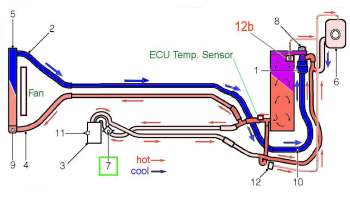
As the engine starts to heat up (being on full throttle) the hot water
from the by-pass (this is injected into the stat housing [No 8] directly
onto the stat wax bulb) opens the stat as far as it can to let more water
flow round the radiator. The water it lets into the stat housing (and
on then into the pump & engine) is way colder than the bypass water
(thatís at engine temp), this hits the wax bulb of the stat and cools
it down dramatically, shutting the stat (this takes about 2 secís), the
engine, in the mean time, gets a sudden injection of cold water, (at 200Liters/min
pump rate), replacing the entire water content of the engine. So all of
a sudden, the cylinder head water jacket goes from 95+C to 40C, then,
as the stat is now shut, starts to heat up all over again.
Now, this is all made worse by the fact that the bottom 2/3rds of the cylinder liners and the rest of the block are cooled by oil. When the engine is in a nice FWD shopping trolley, the oil is cooled by the airflow over the sump, in the Elise there is NO airflow (itís covered by the under-tray). Even with a std un-modified Elise, you can cook the oil on a track in less than 10 minutes, (I have seen oil temps over 160c on std cars!)
Put this all together what you have is the block getting hotter and hotter (and expanding), the head alternating cold/hot (expanding then shrinking) and the head gasket acting like the slip joint between them, thus hey presto Ė blown gasket!
The following just details the mods required to solve the water temp problem, you will still need to do something about cooling the oil.
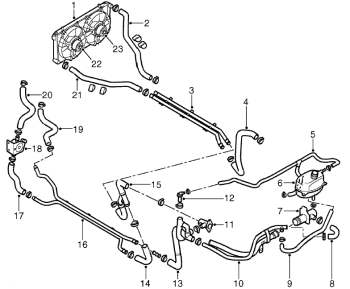
MGF Coolant System is the same (see notice due heater Matrix Valve No
18, hose No 19 and 20)
- Location A from Simons Elise is below of No 15 at the MGF
The solution to this sort of depends on what you use your car for.
- If you just have a road car with an up-rated engine (less than 200Bhp) that occasionally does track-days but mostly is driven around on the road, then the solution is to replace the stat with one that will not increase the volume of by-pass water to ensure speedy warm up times.
- If you have a track/race car with over 200Bhp, you need to replace the stat so that ALL the water in the system becomes the by-pass, except the radiator. The reason for this is that a stat can only open relatively slowly, so if the water temp rises faster than this, you will end up with an oscillating water temp again.
To implement the first, you
need a remote stat with by-pass (ala BMW/Rover SD1 2600/etc.).
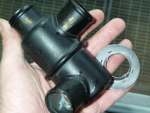 Sample: Biltema 83° remote thermostat
Sample: Biltema 83° remote thermostat 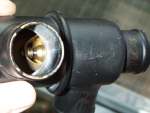
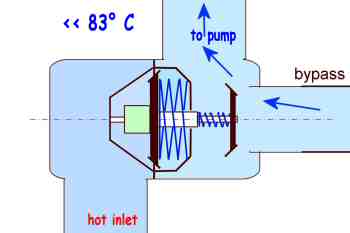
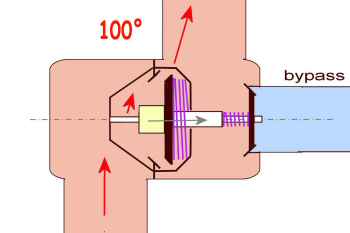
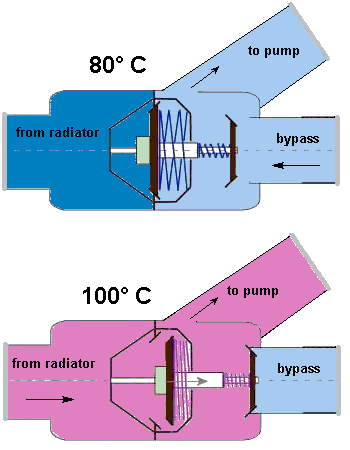 Rover Remote Thermostat
Rover Remote Thermostat
(Picture courtsy Carlos from Italy, Elise S1) see
his Elise conversion
The steps are:
- Remove the old stat from itís plastic housing, punch/cut out the centre, then put the surround back in.
- Where the hot water pipe leaves the engine bay and enters the right hand sill, cut out the T piece of the rubber pipe (this is the feed to the internal heater box).
- Fit the stat so that the inlet is connected to the engine side, the outlet to the radiator side and the by-pass is connected to the heater feed.
- Take the old by-pass hose of the engine outlet (this is the one with the two temp sender units on the branch.
- Block the outlet so that there is only a 2 mm hole in it Ė be careful not to damage the temp senders!
- Put the pipe back on.
- Fill up the water and test for leaks.
The reason for leaving a 2mm hole in the old by-pass is just to ensure that the sender units get a good look at the water exiting the head, Simon found that with his this is unnecessary, but he doesnít use the std wiring anyway.
To do the second, you will need the same type of stat as before, plus a 3 foot length of heater hose and a T adapter to go from radiator pipe to heater hose.
The steps are:
- Remove the old stat from itís plastic housing, punch/cut out the centre, then put the surround back in.
- Cut the radiator feed hose about 5 inches from the radiator and remove the length of the stat from it.
- Insert the stat so that the inlet is away from the radiator and the outlet is towards the radiator.
- Connect the by-pass tap to the heater hose, then run this hose under the crash structure to the other side of the radiator.
- Cut the T into the radiator return hose with the heater hose you have just run under the crash structure. (this is now the by-pass cct)
- Take the old by-pass hose of the engine outlet (this is the one with the two temp sender units on the branch.
- Block the outlet so that there is only a 2 mm hole in it Ė be careful not to damage the temp senders!
- Put the pipe back on.
- Fill up the water and test for leaks.
Coolant modification Update from Carl, 13.01.2001
The only problems with doing this mod is that the engine will now take considerably longer to warm up and the sills will be warm all the time.
In order to get a more stable
cooling system on my "F" I made some changes (thanks for initial
idea goes to Simon ). The "holed thermostat" seems to be a good
way to ensure a more steady flow thru the system and also in minimising
the possibillity of a cold shock for the block and head upon opening of
the thermostat. My alteration includes both the holed thermostat AND the
external bypass with a second thermostat close to the radiator.
Tthermostat with hole and the remote
thermostat at the front
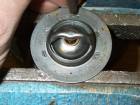

In this way the start from cold includes the bypass at the holed thermostat and as it starts to open up there is more heat at the second remote one. At around 80 deg. C this one starts to blend thru the radiator and gradualy the system comes to blend any cool water in the system.
Now the chance for any cold water shock on the engine at sudden full throttle is minimised and thermal expansion / retraction will hence be much smaller than before. This is good for the headgasket that acts as a separation between the block and the head. Still of course the best solution would be to get the steel dowels as well as a re-inforced headgasketÖ
My alteration to the cooling
system will be closely monitored at several points with temp. senders
to a logging unit in order to find out the time / temp-scale at different
locations.
As the car is still on stands this will be performed mid March when hopefully
sprin is due here in Sweden.
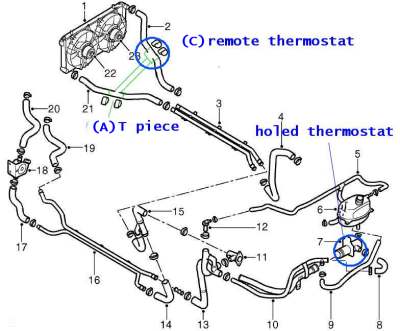
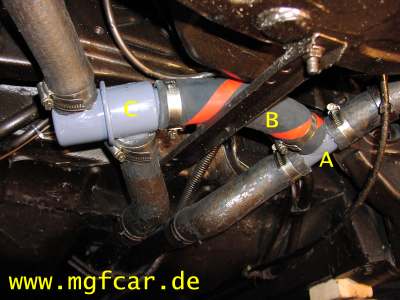 front seen from below
front seen from below
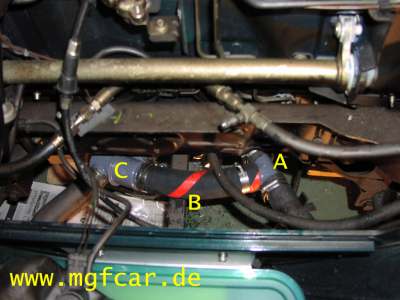 front seen from top
front seen from top
Such Remote Thermostat gets installed to the Freelander already since 2001
PRT (Pressure Relief
Thermostat on MGTF sinc MY 2004 (app.)
Parts required listed in the EPC under
Pipes and Hoses &
Thermostat
Another image of #8 assembly
and #13 assembly courtesy Dave Livingstone UK
old design on the left, new with PRT on the right.
click for larger image
